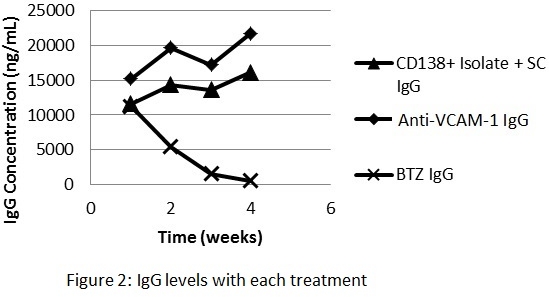Long Term Culture of Functional Bone Marrow-Derived Human Plasma Cells
William J. von Liebig Center for Transplantation and Clinical Regeneration, Mayo Clinic, Rochester, MN.
Meeting: 2018 American Transplant Congress
Abstract number: D11
Keywords: Alloantibodies, Bone marrow, HLA antibodies, IgG
Session Information
Session Name: Poster Session D: B-cell / Antibody
Session Type: Poster Session
Date: Tuesday, June 5, 2018
Session Time: 6:00pm-7:00pm
 Presentation Time: 6:00pm-7:00pm
Presentation Time: 6:00pm-7:00pm
Location: Hall 4EF
Introduction Antibody-secreting plasma cells (PCs) are critically important for host defense, but also can cause antibody-mediated allograft rejection. The ability to study these cells is limited by the difficulty in maintaining survival in vitro. The goal of this study was to develop an in vitro culture model for the long-term maintenance of bone marrow (BM)-derived PCs to gain further insight into the biology of PCs and the effects of certain drugs on antibody-production.
Methods BM was aspirated from kidney transplant recipients under general anesthesia immediately prior to kidney transplant. In 24 well plates, 2×105 CD138+ PCs/well were co-cultured with 7.5×103 irradiated with mouse stromal cells (SCs) and 20ng/ml IL-6. Supernatant from each well was removed weekly and assayed by ELISA IgA, IgG, and IgM, anti-tetanus, anti-measles and anti-HLA IgG (lab screen assay). Ig production was analyzed as log-scale difference in area under the curves was used to measure immunoglobulin production over time and one-sample t-test was used to detect significant differences.
Results Reproducibly high levels of IgG, IgA and IgM antibody were detected by ELISA up to 4 weeks. Antigen-specific IgG against tetanus and measles also were detected. Anti-HLA antibodies in supernatants correlated (see figure) in patients with detectable serum antibody (r=0.95).  The addition of bortezomib dramatically decreased production of Ag-specific antibody Ig of all classes along with significant depletion of PCs while adding VCAM-1 antibody had no effect (Figure shows typical IgG levels with each treatment).
The addition of bortezomib dramatically decreased production of Ag-specific antibody Ig of all classes along with significant depletion of PCs while adding VCAM-1 antibody had no effect (Figure shows typical IgG levels with each treatment). 
Conclusion This PC-SC co-culture model is the first to allow for the reproducible, long-term culture of long-lived human PCs and provides a model to test potential therapies.
CITATION INFORMATION: Moore N., Bonner K., D'Costa M., Stegall M. Long Term Culture of Functional Bone Marrow-Derived Human Plasma Cells Am J Transplant. 2017;17 (suppl 3).
To cite this abstract in AMA style:
Moore N, Bonner K, D'Costa M, Stegall M. Long Term Culture of Functional Bone Marrow-Derived Human Plasma Cells [abstract]. https://atcmeetingabstracts.com/abstract/long-term-culture-of-functional-bone-marrow-derived-human-plasma-cells/. Accessed December 23, 2025.« Back to 2018 American Transplant Congress
